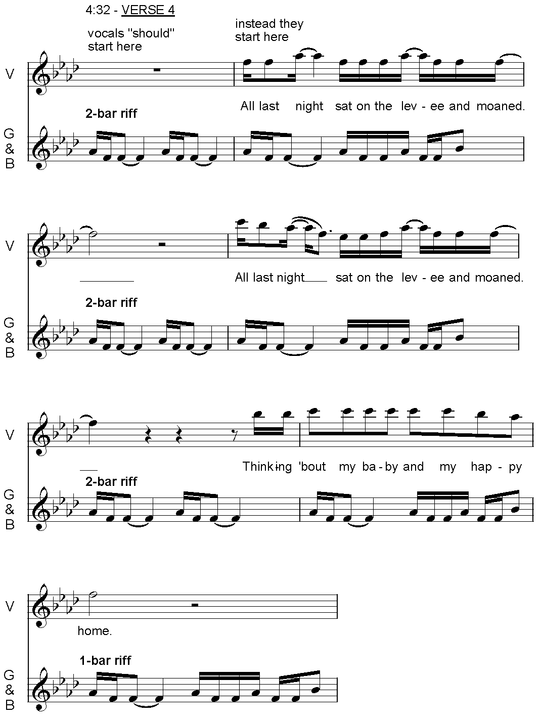|
Another example of rhythmic displacement can be found in “When the Levee Breaks”, the concluding track of Led Zeppelin IV (1971). Jimmy Page's guitar and John Paul Jones' bass play in unison throughout the verses. Their basic riff is a single-measure blues pattern: But often they extended it by twice repeating the first half of the 1-bar riff, yielding a 2-bar riff: Following the initial two measures of solo drums, the introduction continuously juxtaposes these two riffs.
This constant varying of riff durations wards off any threat of monotony and foreshadows the riff patterns used in the verses. Notice how from 0:21-0:44 and from 0:44-1:08 the 2-bar riff is played three times followed by the 1-bar riff once. This seven-measure pattern will be heard in all four verses, where Robert Plant's vocals are added to Page's and Jones' riffs. Since Plant's verse vocals feature three phrases, each two measures long, they coordinate nicely with the 2-bar riffs. The single 1-bar riff at the end of the verse, then, functions as a turnaround, propelling the song to its subsequent section. 1:25-1:49 = Verse 1 (7 measures) 1:25 = 2-bar riff (“If it keeps on raining...”) 1:32 = 2-bar riff (“If it keeps on raining...”) 1:38 = 2-bar riff (“When the levee breaks...”) 1:45 = 1-bar riff (instrumental) That same coordinated pattern is also found in the second and third verses... 1:49-2:13 = Verse 2 1:49 = 2-bar riff (“Mean old levee...”) 1:55 = 2-bar riff (“Mean old levee...”) 2:02 = 2-bar riff (“It's got what it takes...”) 2:09 = 1-bar riff (instrumental) 4:09-4:32 = Verse 3 4:09 = 2-bar riff (“Cryin' won't help...”) 4:15 = 2-bar riff (“Cryin' won't help...”) 4:22 = 2-bar riff (“When the levee breaks...”) 4:29 = 1-bar riff (instrumental) … but not in the fourth verse. In this final iteration, Page and Jones continue as usual while Plant displaces his vocals not by one beat, as we saw in "Dazed and Confused", but by one measure. He "should" start singing at 4:32, but instead enters at 4:36, midway through the 2-bar riff, offsetting the coordinated pattern heard in the three previous verses.
Since the underlying harmony throughout the verses is static, this rhythmic displacement does not cause any harmonic problems the way such a displacement would in, say, "Babe I'm Gonna Leave You" or “Stairway to Heaven” where the harmonies are more fluid.
1 Comment
|
Aaron Krerowicz, pop music scholarAn informal but highly analytic study of popular music. Archives
August 2019
Categories
All
|




 RSS Feed
RSS Feed
